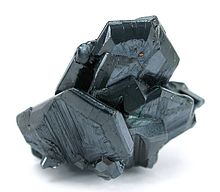- Chalcocite
-
Chalcocite 
General Category Sulfide minerals Chemical formula copper(I) sulfide: Cu2S Strunz classification 02.BA.05a Crystal symmetry Monoclinic 2/m - Prismatic Unit cell a = 15.246(4) Å, b = 11.884(2) Å, c = 13.494(3) Å; β = 116.35(1)°; Z = 96 Identification Color Dark gray to black Crystal habit Tabular to prismatic crystals also massive to granular Crystal system Monoclinic, pseudo-orthorhombic Twinning Common on {110} yielding pseudohexagonal stellate forms Cleavage Indistinct on {110} Fracture Conchoidal Tenacity Brittle to sectile Mohs scale hardness 2.5 - 3 Luster Metallic Streak Shiny black to lead gray Diaphaneity Opaque Specific gravity 5.5 - 5.8 Fusibility 2-2.5 References [1][2][3] Chalcocite, copper(I) sulfide (Cu2S), is an important copper ore mineral. It is opaque, being colored dark-gray to black with a metallic luster. It has a hardness of 2½ - 3. It is a sulfide with an orthorhombic crystal system.
The term chalcocite comes from the alteration of the obsolete name chalcosine, from the Greek khalkos, meaning copper. It is also known as redruthite, vitreous copper and copper-glance.
Occurrence
Chalcocite is sometimes found as a primary vein mineral in hydrothermal veins. However, most chalcocite occurs in the supergene enriched environment below the oxidation zone of copper deposits as a result of the leaching of copper from the oxidized minerals. It is also often found in sedimentary rocks.
It has been mined for centuries and is one of the most profitable copper ores. The reasons for this is its high copper content (67% atomic ratio and nearly 80% by weight) and the ease at which copper can be separated from sulfur.
Since chalcocite is a secondary mineral that forms from the alteration of other minerals, it has been known to form pseudomorphs of many different minerals. A pseudomorph is a mineral that has replaced another mineral atom by atom, but it leaves the original mineral's crystal shape intact. Chalcocite has been known to form pseudomorphs of the minerals bornite, covellite, chalcopyrite, pyrite, enargite, millerite, galena and sphalerite.
See also
References
- Dana's Manual of Mineralogy ISBN 0-471-03288-3
- Mineral Galleries
Ores Acanthite (silver) · Chalcopyrite (copper) · Chalcocite (copper) · Cinnabar (mercury) · Galena (lead) · Pentlandite (nickel) · Sphalerite (zinc)OtherOre deposit types Banded iron formation · Carbonate hosted lead zinc ore deposits · Heavy mineral sands · Iron oxide copper gold · Kambalda type komatiitic nickel ore deposits · Lateritic nickel · Magmatic nickel-copper-iron-PGE deposits · Porphyry copper · Sedimentary exhalative deposits · Volcanogenic massive sulfideCategories:- Copper minerals
- Sulfide minerals
- Orthorhombic minerals
Wikimedia Foundation. 2010.

